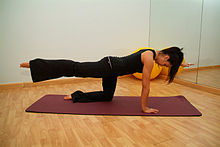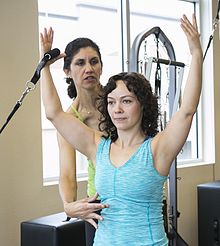The Buteyko method or Buteyko breathing technique is a form of complementary or alternative physical therapy that proposes the use of breathing exercises primarily as a treatment for asthma and other respiratory conditions.
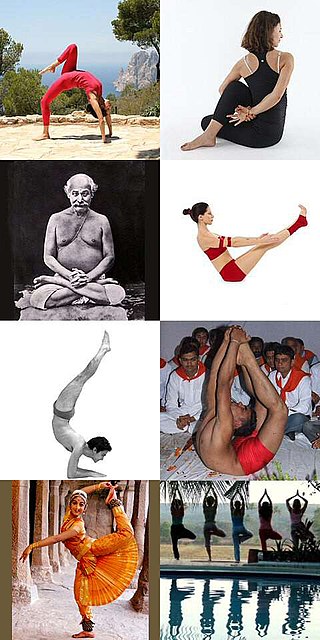
An āsana is a body posture, originally and still a general term for a sitting meditation pose, and later extended in hatha yoga and modern yoga as exercise, to any type of position, adding reclining, standing, inverted, twisting, and balancing poses. The Yoga Sutras of Patanjali define "asana" as "[a position that] is steady and comfortable". Patanjali mentions the ability to sit for extended periods as one of the eight limbs of his system. Asanas are also called yoga poses or yoga postures in English.
Mind–body interventions (MBI) or mind-body training (MBT) are health and fitness interventions that are intended to work on a physical and mental level such as yoga, tai chi, and Pilates.

Strength training, also known as weight training or resistance training, involves the performance of physical exercises that are designed to improve strength and endurance. It is often associated with the lifting of weights. It can also incorporate a variety of training techniques such as bodyweight exercises, isometrics, and plyometrics.
Joseph Hubertus Pilates was a German physical trainer, writer, and inventor. He is credited with inventing and promoting the Pilates method of physical fitness. He patented a total of 26 apparatuses in his lifetime.

An exercise ball is a ball constructed of soft elastic, typically in 5 diameters of 10 cm increments, from 35 to 85 cm, and filled with air. The air pressure is changed by removing a valve stem and either filling with air or letting the ball deflate. It is most often used in physical therapy, athletic training and exercise. It can also be used for weight training.
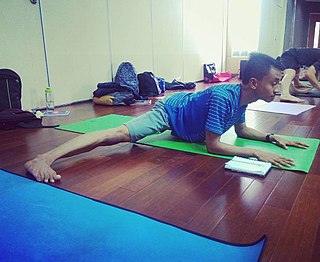
Yoga as therapy is the use of yoga as exercise, consisting mainly of postures called asanas, as a gentle form of exercise and relaxation applied specifically with the intention of improving health. This form of yoga is widely practised in classes, and may involve meditation, imagery, breath work (pranayama) and calming music as well as postural yoga.
Functional training is a classification of exercise which involves training the body for the activities performed in daily life.
In kinesiology, core stability is a person's ability to stabilize their core. Stability, in this context, should be considered as an ability to control the position and movement of the core. Thus, if a person has greater core stability, they have a greater level of control over the position and movement of this area of their body. The body's core is frequently involved in aiding other movements of the body, such as running; thus it is known that improving core stability also improves a person's ability to perform these other movements.
Aquatic therapy refers to treatments and exercises performed in water for relaxation, fitness, physical rehabilitation, and other therapeutic benefit. Typically a qualified aquatic therapist gives constant attendance to a person receiving treatment in a heated therapy pool. Aquatic therapy techniques include Ai Chi, Aqua Running, Bad Ragaz Ring Method, Burdenko Method, Halliwick, Watsu, and other aquatic bodywork forms. Therapeutic applications include neurological disorders, spine pain, musculoskeletal pain, postoperative orthopedic rehabilitation, pediatric disabilities, pressure ulcers, and disease conditions, such as osteoporosis.
Pulmonary rehabilitation, also known as respiratory rehabilitation, is an important part of the management and health maintenance of people with chronic respiratory disease who remain symptomatic or continue to have decreased function despite standard medical treatment. It is a broad therapeutic concept. It is defined by the American Thoracic Society and the European Respiratory Society as an evidence-based, multidisciplinary, and comprehensive intervention for patients with chronic respiratory diseases who are symptomatic and often have decreased daily life activities. In general, pulmonary rehabilitation refers to a series of services that are administered to patients of respiratory disease and their families, typically to attempt to improve the quality of life for the patient. Pulmonary rehabilitation may be carried out in a variety of settings, depending on the patient's needs, and may or may not include pharmacologic intervention.
Forrest Yoga is a style of yoga as exercise. It was created by and named for Ana T. Forrest in 1982. It is known for "its long holding of positions, emphasis on abdominal core work, and standing series that can go on for 20 poses on each side". Reputed for its intensity, the style emphasizes connecting to one's feelings in order to work through physical and emotional trauma.

Core Strength Vinyasa Yoga is a style of yoga as exercise created by American yogini Sadie Nardini in 2006. Central to this style is a movement referred to as a 'wave' (softening). The structure of this practice includes a 7-step framework which is applied to each pose within a sequence. Nardini incorporates aspects of Kundalini Yoga, Sivananda Yoga, Anusara Yoga, Iyengar Yoga, and portions of movement sequences from Ashtanga Vinyasa Yoga. Maintaining an internal focus on joy in the moment is part of the practice philosophy. This style integrates postures with learnings from many disciplines including physics, biology, and geometry, influenced by the works of Leslie Kaminoff. It incorporates traditional yoga philosophy from the Yoga Sutras of Patanjali. It emphasizes muscles that are deep within the body and includes the use of 'waves' in order to enter and exit poses. Examples include physical moves that activate muscles close to the spine—such as psoas and quadratus lumborum in order to build support for the body from within before generating outward expression of that movement. The purpose of deep core focused poses in this practice is to improve and deepen breathing. This perspective differs from other styles in which the purpose of deep core work is to stabilize the back. In this practice, keeping belly soft and core strong improve breathing. "Belly Bonfire" breath is one example of a deep core breath technique that involves focus and target of attention and breath with softer abs. Pelvis is viewed as the body's physical center of gravity in this system.

Barre is a form of physical exercise, usually conducted in group classes in gyms or specialty studios. It is distinguished from other group fitness activities by its use of the ballet barre and its incorporation of movements derived from ballet. These classical dance movements and positions are combined with those drawn from yoga and pilates, and other equipment is sometimes used in addition to the barre, such as resistance bands, yoga straps, exercise balls and hand weights. Barre classes typically focus on small, pulsing movements with emphasis on form, alignment and core engagement. Participants hold their bodies still while contracting specific, targeted sets of muscles in isometric exercises. Repetitions tend to be high, range-of-motion small, and weights, when used, light. Barre classes focus on the lower body and core, developing strength and flexibility from the ankles up though the calves, knees, thighs, glutes and abdominals. Holding muscles in contraction for extended periods frequently leads to them shaking as they fatigue. This is particularly true of thighs, as the quadriceps tire.
Trauma-sensitive yoga is yoga as exercise, adapted from 2002 onwards for work with individuals affected by psychological trauma. Its goal is to help trauma survivors to develop a greater sense of mind-body connection, to ease their physiological experiences of trauma, to gain a greater sense of ownership over their bodies, and to augment their overall well-being. However, a 2019 systematic review found that the studies to date were not sufficiently robustly designed to provide strong evidence of yoga's effectiveness as a therapy; it called for further research.

Yoga as exercise is a physical activity consisting mainly of postures, often connected by flowing sequences, sometimes accompanied by breathing exercises, and frequently ending with relaxation lying down or meditation. Yoga in this form has become familiar across the world, especially in the US and Europe. It is derived from medieval Haṭha yoga, which made use of similar postures, but it is generally simply called "yoga". Academics have given yoga as exercise a variety of names, including modern postural yoga and transnational anglophone yoga.

The science of yoga is the scientific basis of modern yoga as physical exercise in human sciences such as anatomy, physiology, and psychology. Yoga's effects are to some extent shared with other forms of exercise, though it differs in the amount of stretching involved, and because of its frequent use of long holds and relaxation, in its ability to reduce stress. Yoga is here treated separately from meditation, which has effects of its own, though yoga and meditation are combined in some schools of yoga.

Props used in yoga include chairs, blocks, belts, mats, blankets, bolsters, and straps. They are used in postural yoga to assist with correct alignment in an asana, for ease in mindful yoga practice, to enable poses to be held for longer periods in Yin Yoga, where support may allow muscles to relax, and to enable people with movement restricted for any reason, such as stiffness, injury, or arthritis, to continue with their practice.
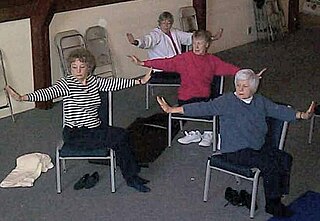
Accessible yoga is a form of modern yoga as exercise with adapted asanas designed to be suitable for people who are unable to follow a standard yoga class through age, illness, or disability. It includes various forms of what has been called Chair Yoga, and has also been described as adaptive yoga.

Gyrotonic, also known as the Gyrotonic Expansion System, is a system of exercise that was developed by Juliu Horvath in the 1980s. It is centered around enhancing spinal movement in three dimensions, which not only focuses on increasing the functional mobility of the spine but also building the strength and flexibility of the muscles surrounding it. It focuses on using spiral and circular patterns to move the body in all three planes: frontal, sagittal, and horizontal. The system consists of two complementary exercise methods - the Gyrotonic and Gyrokinesis Methods.
